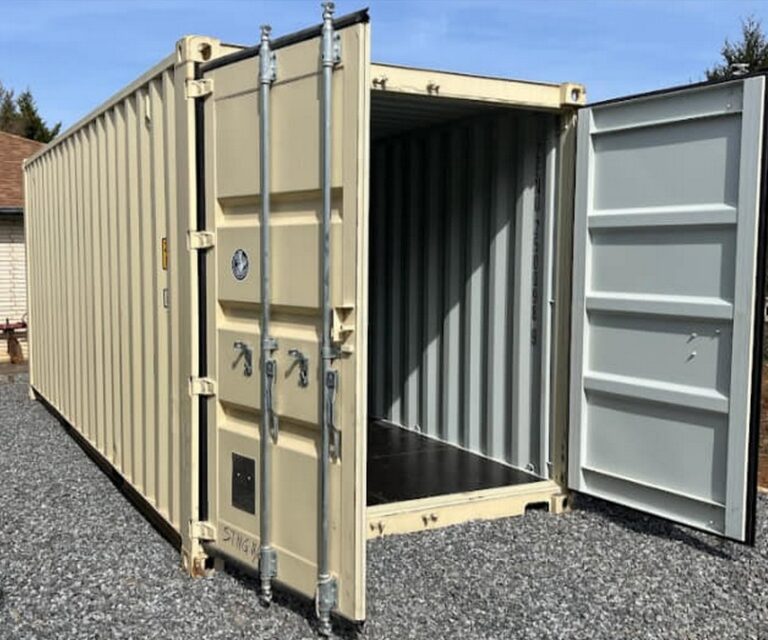Seismic Safety for Shipping Container Structures: The Ultimate Guide to Earthquake-Resistant Designs
Shipping container structures are becoming a preferred choice for homes, offices, and commercial spaces due to their affordability, durability, and sustainability. However, in earthquake-prone areas, ensuring seismic safety is critical. Even though shipping containers are constructed from high-strength Corten steel, they must be properly engineered, reinforced, and anchored to withstand seismic activity and comply with seismic building codes.
In this guide, we will explore everything you need to know about earthquake-resistant shipping container structures, including:
✅ The impact of earthquakes on shipping container buildings
✅ Building codes and seismic design categories for container structures
✅ Foundation requirements for earthquake resilience
✅ Structural reinforcement techniques for improved seismic strength
✅ Anchoring methods and seismic retrofitting strategies
✅ Real-life case studies of shipping containers in earthquake-prone regions
✅ Advanced FAQ section answering critical seismic safety questions
By applying these best practices, you can construct a resilient and compliant shipping container home or business that meets seismic standards and withstands strong earthquakes.

1. The Science Behind Seismic Safety in Shipping Containers
How Do Earthquakes Impact Shipping Container Homes?
Earthquakes generate seismic waves, creating ground motion that can cause buildings to shake, tilt, or collapse if they are not properly designed. Shipping container structures, while made of strong steel, require additional reinforcement to avoid the following hazards:
Common Seismic Hazards for Shipping Containers
🔹 Lateral Forces – Earthquake tremors exert side-to-side pressure, causing shifting or tilting.
🔹 Foundation Failure – Weak foundations may crack, sink, or detach from the ground.
🔹 Structural Integrity Issues – Unreinforced doors, windows, and openings weaken container strength.
🔹 Stacked Container Instability – Multi-story container homes can topple without proper seismic reinforcement.
📌 Understanding these risks is essential when designing a seismically stable shipping container structure.
2. Understanding Seismic Building Codes and Regulations
What Are Seismic Building Codes?
Seismic building codes establish structural safety requirements to protect shipping container homes and offices in earthquake-prone areas. These codes define seismic design categories based on ground motion risks and site conditions.
Key Seismic Building Codes for Shipping Containers
📌 International Building Code (IBC) – Sets seismic design categories for various structures.
📌 California Building Code (CBC) – Requires advanced earthquake-resistant designs.
📌 International Residential Code (IRC) – Covers container homes used as primary residences.
📌 American Society of Civil Engineers (ASCE 7) – Defines seismic load paths and structural integrity requirements.
📌 Federal Emergency Management Agency (FEMA) Guidelines – Provides best practices for seismic-resistant buildings.
📌 To ensure compliance, work with a structural engineer to verify that your container home meets local seismic requirements.
3. Seismic Design Categories and Risk Assessments
What Are Seismic Design Categories?
Seismic design categories (SDCs) determine the level of reinforcement needed for structures based on their location and expected earthquake intensity.
Seismic Design Categories (SDCs) for Shipping Containers
✅ SDC A & B (Low-Risk Zones) – Minimal seismic reinforcement required.
✅ SDC C (Moderate Risk) – Foundation anchoring and structural bracing recommended.
✅ SDC D & E (High-Risk Areas) – Requires advanced seismic reinforcements, base isolators, and energy dissipation systems.
✅ SDC F (Extreme Risk) – Must follow strict seismic retrofitting and damage-tolerant designs.
📌 In California, Oregon, and Washington, most container homes fall under SDC D or E, requiring strong anchoring and structural reinforcement.
4. Foundation Requirements for Earthquake Resistance
A strong foundation is crucial for maintaining seismic safety. A poorly designed foundation can lead to severe damage or structural collapse.
Best Foundations for Shipping Containers in Seismic Zones
🏗 Concrete Slab Foundation – Provides maximum stability against earthquakes.
🏗 Deep Concrete Piers – Enhances seismic strength by securing containers deep underground.
🏗 Seismic Base Isolators – Absorbs ground motion energy, reducing earthquake impact.
🏗 Ballast Foundations – Uses added weight to prevent shifting or tilting.
📌 All foundation designs must comply with building codes and seismic risk assessments to ensure safety.
5. Structural Reinforcement for Seismic Safety
While shipping containers are inherently strong, they need additional reinforcement to withstand seismic forces.
Essential Structural Reinforcements for Shipping Containers
✅ Cross-Bracing Systems – Prevents lateral movement during earthquakes.
✅ Reinforced Welded Steel Plates – Strengthens walls, roofs, and floors.
✅ Shock-Absorbing Materials – Reduces stress concentration during tremors.
✅ Load Path Optimization – Ensures seismic forces are evenly distributed.
📌 Proper reinforcement is especially important for stacked container buildings, which require extra bracing and anchoring.
6. Anchoring Strategies for Seismic Stability
Anchoring is essential to prevent containers from shifting or overturning during an earthquake.
Best Anchoring Techniques for Shipping Containers
🔹 Bolted Hold-Down Anchors – Secure containers to reinforced concrete slabs.
🔹 Embedded Steel Plates – Provide additional seismic strength.
🔹 Seismic Cable Tie-Downs – Allows controlled movement while preventing collapse.
🔹 Foundation Reinforcement with Anchors – Prevents upheaval or sliding.
📌 California seismic codes require engineer-approved anchoring systems for shipping container structures.
Real-Life Case Study: How Shipping Container Structures Performed in Earthquakes
Case Study #1: The 2011 Christchurch Earthquake
In 2011, a 6.3-magnitude earthquake struck Christchurch, New Zealand. While traditional buildings collapsed, Re:START Mall, a shipping container shopping center, withstood the tremors with minimal damage.
Why Did It Survive?
✔ Seismic Strength & Modular Design – Shipping containers provided structural redundancy.
✔ Reinforced Foundations – Containers were bolted to concrete slabs, preventing movement.
✔ Flexible Seismic Configuration – Allowed controlled movement, reducing structural stress.
📌 This case study demonstrates that properly reinforced shipping container structures can survive major earthquakes.
Case Study #2: The Christchurch Earthquake and Container Homes
In 2011, a 6.3-magnitude earthquake struck Christchurch, New Zealand. Many traditional buildings collapsed, but shipping container structures in the city survived with minimal damage.
Why Did They Survive?
✔ Strong Steel Frame – Shipping containers are made from Corten steel, which resists cracking and bending under stress.
✔ Reinforced Foundations – Containers were bolted into deep concrete piers, preventing movement.
✔ Seismic Load Distribution – Engineers used cross-bracing and damping systems to distribute earthquake forces evenly.
Case Study #3: Japan’s Container Hotels Designed for Earthquake Resistance
Japan is known for innovative earthquake-resistant buildings, and several companies have built seismic-safe container hotels in earthquake-prone regions.
Seismic Features of Japan’s Container Hotels:
✔ Flexible Modular Design – Containers are arranged to allow controlled movement, reducing damage.
✔ Seismic Base Isolators – These absorb seismic energy, preventing direct impact.
✔ Redundant Load Paths – The structures include multiple support points, so no single area carries all the force.
FAQ: Common Questions About Seismic Safety in Shipping Containers
Can a shipping container survive an earthquake?
Yes, shipping container structures can withstand earthquakes, but only when they are properly reinforced, anchored, and designed according to seismic codes. The natural strength of Corten steel provides a good starting point, but additional reinforcements such as bracing, foundation anchoring, and seismic dampers are needed for high-risk earthquake zones.
What are seismic design categories (SDCs), and why do they matter?
Seismic Design Categories (SDCs) classify buildings based on their earthquake risk level. These categories determine the amount of reinforcement and engineering required for safety:
- SDC A & B – Low seismic risk, minimal reinforcements needed.
- SDC C – Moderate risk, requires foundation anchoring and lateral bracing.
- SDC D & E – High risk, requires extensive seismic reinforcements and base isolators.
- SDC F – Extreme risk, mandatory seismic dampers, redundancy reinforcements, and energy dissipation systems.
What states require seismic safety measures for container homes?
States with high seismic activity, including California, Oregon, Washington, Alaska, Nevada, and Hawaii, have strict seismic building codes. Container homes in these states must comply with California Building Code (CBC), International Building Code (IBC), and ASCE 7 standards.
How do I obtain a permit for a shipping container home in a seismic zone?
To get a permit, you must:
- Conduct a seismic hazard analysis.
- Submit engineered structural drawings that show reinforcements.
- Get approval for foundation and anchoring methods.
- Pass local inspections based on seismic building codes.
What is the best foundation for a shipping container in an earthquake-prone area?
The best foundation for seismic stability depends on soil conditions and the seismic risk level. Common solutions include:
- Concrete Slab Foundations – Best for high seismic zones, prevents movement.
- Deep Concrete Piers – Provides strong seismic resistance by securing the container below ground level.
- Base Isolators – Reduces the effects of ground shaking by absorbing seismic energy.
How can I reinforce my shipping container home for seismic safety?
✅ Cross-bracing systems to prevent torsional movement.
✅ Steel reinforcement beams for structural integrity.
✅ Shock-absorbing materials to dissipate seismic energy.
✅ Load path optimization to distribute seismic forces evenly.
Do stacked shipping container homes require additional seismic reinforcements?
Yes! Multi-story container structures must include:
✔ Reinforced columns to prevent toppling.
✔ Cross-bracing at connection points.
✔ Bolted steel plates at all stacking joints.
✔ Seismic anchoring systems to reduce sliding risk.
Internal Links to Explore Further
- Do You Need a Permit for a Shipping Container Home? Everything You Need to Know
- Shipping Container Zoning Laws by State: A Complete Guide for Homeowners & Businesses
- Complete Guide: Shipping Container Zoning Laws in All 50 States
- Best Locks for Shipping Containers: Protect Your Cargo with High-Security Solutions
- Best Shipping Container Security Camera Systems: 24/7 Surveillance & Remote Monitoring
- How to Burglar-Proof a Shipping Container: The Ultimate Security Guide
- Fire Safety Tips for Shipping Container Storage
- Shipping Container Fireproofing Methods: Protecting Your Fire-Resistant Storage and Living Spaces
- Insurance for Shipping Container Homes: Everything You Need to Know
- How to Comply with Shipping Container Building Codes: A Step-by-Step Guide
- Are Shipping Containers Safe to Live In?
- Are Shipping Containers Waterproof?
Get quote!

No strings attached 💯